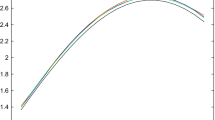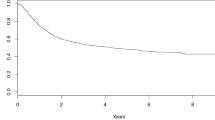Abstract
In some situations, the failure time of interest is defined as the gap time between two related events and the observations on both event times can suffer either right or interval censoring. Such data are usually referred to as doubly censored data and frequently encountered in many clinical and observational studies. Additionally, there may also exist a cured subgroup in the whole population, which means that not every individual under study will experience the failure time of interest eventually. In this paper, we consider regression analysis of doubly censored data with a cured subgroup under a wide class of flexible transformation cure models. Specifically, we consider marginal likelihood estimation and develop a two-step approach by combining the multiple imputation and a new expectation-maximization (EM) algorithm for its implementation. The resulting estimators are shown to be consistent and asymptotically normal. The finite sample performance of the proposed method is investigated through simulation studies. The proposed method is also applied to a real dataset arising from an AIDS cohort study for illustration.
Similar content being viewed by others
References
Chen, M. H., Ibrahim, J. G., Sinha, D.: A new Bayesian model for survival data with a surviving fraction. J. Amer. Statist. Assoc., 94, 909–919 (1999)
Chen, L., Lin, D. Y., Zeng, D. L.: Checking semiparametric transformation models with censored data. Biostatistics, 13, 18–31 (2011)
De Gruttola, V. G., Lagakos, S. W.: Analysis of doubly-censored survival data, with application to AIDS. Biostatistics, 45, 1–11 (1989)
Goggins, W. B., Finkelstein, D. M., Zaslavsky, A. M.: Applying the Cox proportional hazards model for analysis of latency data with interval censoring. Stat. Med., 18, 2737–2747 (1999)
Hu, T., Xiang, L. M.: Efficient estimation for semiparametric cure models with interval-censored data. J. Multivariate Anal., 121, 139–151 (2013)
Huang, J.: Asymptotic properties of nonparametric estimation based on partly interval-censored data. Stat. Sinica, 9, 501–519 (1999)
Kim, M. Y., De Gruttola, V. G., Lagakos, S. W.: Analyzing doubly censored data with covariates, with application to AIDS. Biometrics, 45, 13–22 (1993)
Kosorok, M. R.: Introduction to Empirical Processes and Semiparametric Inference, Springer, New York, 2008
Kosorok, M. R., Lee, B. L., Fine, J. P.: Robust inference for univariate proportional hazards frailty regression models. Ann. Stat., 32, 1448–1491 (2004)
Kuk, A. Y. C., Chen, C. H.: A mixture model combining logistic regression with proportional hazards regression. Biometrika, 79, 531–541 (1992)
Li, S. W., Hu, T., Wang, P., Sun, J. G.: Regression analysis of current status data in the presence of dependent censoring with applications to tumorigenicity experiments. Comput. Stat. Data Anal., 110, 75–86 (2017)
Li, S. W., Sun, J. G., Tian, T., Cui, X.: Semiparametric regression analysis of doubly censored failure time data from cohort studies. Lifetime Data Anal., 17, 24–41 (2019)
Liu, H., Shen, Y. A.: Semiparametric regression cure model for interval-censored data. J. Amer. Statist. Assoc., 104, 1168–1178 (2009)
Lu, W. B., Ying, Z. L.: On semiparametric transformation cure models. Biometrika, 91, 331–343 (2004)
Ma, S. G.: Mixed case interval censored data with a cured subgroup. Stat. Sinica, 20: 1165–1181 (2010)
Mao, M., Wang, J. L.: Semiparametric efficient estimation for a class of generalized proportional odds cure models. J. Amer. Statist. Assoc., 105, 302–311 (2010)
Mykland, P. A., Ren, J. J.: Algorithms for computing self-consistent and maximum likelihood estimators with doubly censored data. Ann. Stat., 24, 1740–1764 (1996)
Pan, W.: A multiple imputation approach to regression analysis for doubly censored data with application to AIDS studies. Biometrics, 57, 1245–1250 (2001)
Rubin, D. B.: Multiple Imputation for Nonresponse in Surveys, John Wiley & Sons, New Jersey, 2004
Rudin, W.: Functional Analysis, McGraw-Hill, New York, 1973
Su, Y. R., Wang, J. L.: Semiparametric efficient estimation for shared-frailty models with doubly-censored clustered data. Ann. Stat., 44, 1298–1331 (2016)
Sun, L. Q., Kim, Y. J., Sun, J. G.: Regression analysis of doubly censored failure time data using the additive hazards model. Biometrics, 60, 637–643 (2004)
Sun, J. G., Liao, Q. M., Pagano M. Regression analysis of doubly censored failure time data with applications to AIDS studies. Biometrics, 55, 909–914 (1999)
Van Der Vaart, A. W., Wellner, J. A.: Weak Convergence and Empirical Processes, Springer, New York, 1996
Wang, P. J., Tong, X. W., Sun, J. G.: A semiparametric regression cure model for doubly censored data. Lifetime Data Anal., 24, 492–508 (2018)
Zeng, D. L., Gao, F., Lin, D. Y.: Maximum likelihood estimation for semiparametric regression models with multivariate interval-censored data. Biometrika, 104, 505–525 (2017)
Zeng, D. L., Mao, L., Lin, D. Y.: Maximum likelihood estimation for semiparametric transformation models with interval-censored data. Biometrika, 103, 253–271 (2016)
Zeng, D. L., Yin, G. S., Ibrahim, J. G.: Semiparametric transformation models for survival data with a cure fraction. J. Amer. Statist. Assoc., 101, 670–684 (2006)
Acknowledgements
We thank the referees for their time and comments.
Author information
Authors and Affiliations
Corresponding author
Additional information
Supported by the National Natural Science Foundation of China (Grant Nos. 11771431, 11690015, 11926341, 11901128 and 11601097), Key Laboratory of RCSDS, CAS (Grant Nos. 2008DP 173182) and Natural Science Foundation of Guangdong Province of China (Grant No. 2018A030310068)
Rights and permissions
About this article
Cite this article
Cai, M., Xiao, L.Q. & Li, S.W. Regression Analysis of Doubly Censored Data with a Cured Subgroup under a Class of Promotion Time Cure Models. Acta. Math. Sin.-English Ser. 37, 835–853 (2021). https://doi.org/10.1007/s10114-021-0151-x
Received:
Revised:
Accepted:
Published:
Issue Date:
DOI: https://doi.org/10.1007/s10114-021-0151-x




